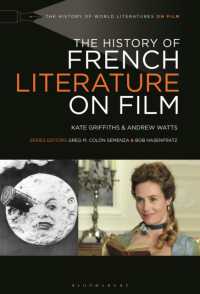- ホーム
- > 洋書
- > 英文書
- > Literary Criticism
基本説明
Examines the relationship between language and violence, focusing on American literature from the Civil War, World War I, and World War II.
Full Description
The Language of War examines the relationship between language and violence, focusing on American literature from the Civil War, World War I, and World War II. James Dawes proceeds by developing two primary questions: How does the strategic violence of war affect literary, legal, and philosophical representations? And, in turn, how do such representations affect the reception and initiation of violence itself? Authors and texts of central importance in this far-reaching study range from Louisa May Alcott and William James to William Faulkner, the Geneva Conventions, and contemporary American organizational sociology and language theory.
The consensus approach in literary studies over the past twenty years has been to treat language as an extension of violence. The idea that there might be an inverse relation between language and violence, says Dawes, has all too rarely influenced the dominant voices in literary studies today. This is an ambitious project that not only makes a serious contribution to American literary history, but also challenges some of the leading theoretical assumptions of our day.
Contents
Acknowledgments Introduction Language and Violence: The Civil War and Literary and Cultural Theory 1. Counting on the Battlefield: Literature and Philosophy after the Civil War 2. Care and Creation: The Anglo-American Modernists 3. Freedom, Luck, and Catastrophe: Ernest Hemingway, John Dewey, and Immanuel Kant 4. Trauma and the Structure of Social Norms: Literature and Theory between the Wars 5. Language, Violence, and Bureaucracy: William Faulkner, Joseph Heller, and Organizational Sociology 6. Total War, Anomie, and Human Rights Law Notes Index







